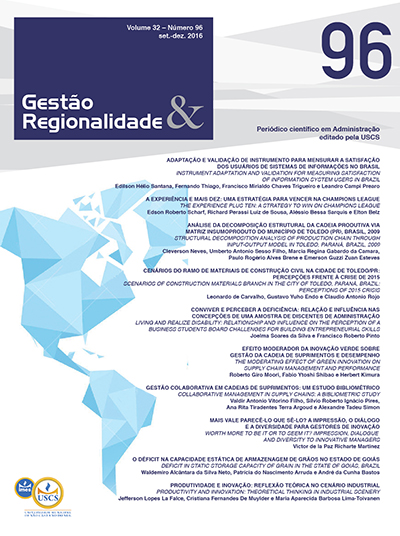Structural decomposition analysis of production chain through input-output model in Toledo, Paraná, Brazil, 2009
DOI:
https://doi.org/10.13037/gr.vol32n96.3296Abstract
The objective of the study is to analyze the productive structure of the Toledo municipality (Brazil) for 2009, as well as the direct and indirect effects on intersectorial production, employment, and income, calculated from the municipal input-output model (IOM). For this, the method proposed by Guilhoto and Sesso Filho, which estimated Brazil’s IOM for 2009, was applied. From the methodology of the location quotient (QL) proposed by Miller and Blair, together with the method proposed by Brene et al., the municipal IOM is estimated, using data collected from the Annual Relation of Social Information (RAIS) of the Brazilian Ministry of Labor and Employment. In the research it was identified that the chemical and pharmaceutical industry sector is the driving force of the Toledan economy, containing the greatest power of linkage among the sectors of the local supply chain. Identification of key sectors is the first step to strategic formulations of sectorial policies that actually promote local economic growth.
Downloads
Downloads
Published
How to Cite
Issue
Section
License
Autores que publicam nesta revista concordam com os seguintes termos:
- Autores mantém os direitos autorais e concedem à revista o direito de primeira publicação, com o trabalho simultaneamente licenciado sob a https://creativecommons.org/
licenses/by-nc-nd/4.0/ , permitindo o compartilhamento do trabalho com reconhecimento da autoria do trabalho e publicação inicial nesta revista. - Autores têm autorização para assumir contratos adicionais separadamente, para distribuição não-exclusiva da versão do trabalho publicada nesta revista (ex.: publicar em repositório institucional ou como capítulo de livro), com reconhecimento de autoria e publicação inicial nesta revista.
- Autores têm permissão e são estimulados a publicar e distribuir seu trabalho online (ex.: em repositórios institucionais ou na sua página pessoal) a qualquer ponto antes ou durante o processo editorial, já que isso pode gerar alterações produtivas, bem como aumentar o impacto e a citação do trabalho publicado (Veja O Efeito do Acesso Livre).
























